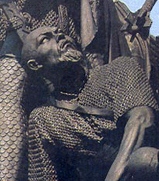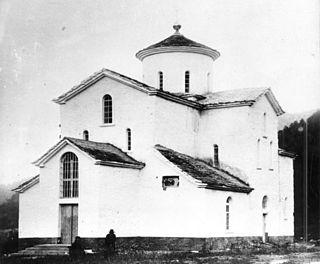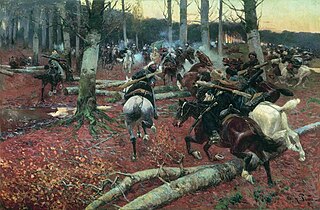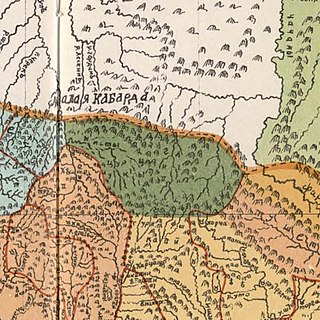
Chechnya, officially the Chechen Republic, is a republic of Russia. It is situated in the North Caucasus of Eastern Europe, close to the Caspian Sea. The republic forms a part of the North Caucasian Federal District, and shares land borders with the country of Georgia to its south; with the Russian republics of Dagestan, Ingushetia, and North Ossetia-Alania to its east, north, and west; and with Stavropol Krai to its northwest.

The Alans were an ancient and medieval Iranian nomadic pastoral people of the North Caucasus – generally regarded as part of the Sarmatians, and possibly related to the Massagetae. Modern historians have connected the Alans with the Central Asian Yancai of Chinese sources and with the Aorsi of Roman sources. Having migrated westwards and becoming dominant among the Sarmatians on the Pontic–Caspian steppe, the Alans are mentioned by Roman sources in the 1st century CE. At that time they had settled the region north of the Black Sea and frequently raided the Parthian Empire and the Caucasian provinces of the Roman Empire. From 215 to 250 CE the Goths broke their power on the Pontic Steppe.

Mamai was a powerful Mongol military commander of the Golden Horde. Contrary to popular misconception, he was not a khan (king), but was a kingmaker for several khans, and dominated parts or all of the Golden Horde for a period of almost two decades in the 1360s and 1370s. Although he was unable to stabilize central authority during the war of succession known as the Great Troubles, Mamai remained a remarkable and persistent leader for decades, while others came and went in rapid succession. His defeat in the Battle of Kulikovo marked the beginning of the decline of the Horde, as well as his own rapid downfall.
The history of Chechnya may refer to the history of the Chechens, of their land Chechnya, or of the land of Ichkeria.
The Chechens, historically also known as Kisti and Durdzuks, are a Northeast Caucasian ethnic group of the Nakh peoples native to the North Caucasus. They are the largest ethnic group of the North Caucasus and refer to themselves as Nokhchiy. The vast majority of Chechens are Muslims and live in Chechnya, a republic of Russia.

Ingushetia or Ingushetiya, officially the Republic of Ingushetia, is a republic of Russia located in the North Caucasus of Eurasia. The republic is part of the North Caucasian Federal District, and shares land borders with the country of Georgia to its south; and borders the Russian republics of North Ossetia–Alania to its west and north and Chechnya to its east and northeast.
Ingush, historically known as Durdzuks, Gligvi and Kists, are an ethnic group mainly inhabiting Ingushetia in central Caucasus, but also inhabitanting Prigorodny District and town of Vladikavkaz of modern day North-Ossetia. The Ingush are predominantly Sunni Muslims and speak the Ingush language.

The Caucasian Imamate, also known as the Caucasus Imamate, was a state established by the imams in Dagestan and Chechnya during the early-to-mid 19th century in the North Caucasus, to fight against the Russian Empire during the Caucasian War, where Russia sought to conquer the Caucasus in order to secure communications with its new territories south of the mountains.

The Republic of North Ossetia – Alania is a federal subject of Russia, located in the Caucasus region.

Although Islam is a minority religion in Russia, Russia has the largest Muslim population in Europe. According to the US Department of State in 2017, Muslims in Russia numbered 14 million or roughly 10% of the total population. The Grand Mufti of Russia, Sheikh Rawil Gaynetdin, estimated the Muslim population of Russia at 25 million in 2018.

The Mountainous Republic of the Northern Caucasus (MRNC), also referred to as the United Republics of the North Caucasus, Mountain Republic, or the Republic of the Mountaineers, was a state in the North Caucasus that emerged during the Russian Civil War and existed from 1917 to 1922. It formed as a consolidation of various Caucasian ethnic groups, including the Circassians, Chechens, Karachays, Ossetians, Balkars, Ingush, and Dagestanis.
Mukhsha Ulus, or Naruchat Duchy was a subdivision of Golden Horde in Middle Mokshaland, modern Mordovia, Penza Oblast and Tambov Oblast of Russia in 13th-15th centuries with the capital in Mukhsha. Population was mainly Mokshas, Mişär Tatars, and Burtas. In 1313–1367 years coined own money. Population was mostly agricultural. Some were cattle-breeders and craftsmen. The main territory of the ulus (district) was situated between rivers Sura and Tsna.

The Caucasian War or Caucasus War was a 19th-century military conflict between the Russian Empire and various peoples of the North Caucasus who resisted subjugation during the Russian conquest of the Caucasus. It consisted of a series of military actions waged by the Russian Imperial Army and Cossack settlers against the native inhabitants such as the Adyghe, Abaza–Abkhaz, Ubykhs, Chechens, and Dagestanis as the Tsars sought to expand.
During the 13th and 14th centuries, the Mongols launched two long, massive invasions of the territory of modern Chechnya and Ingushetia, which included the lands of Alania in the West, Simsir in the Northeast, and the Georgian-allied polity of Durdzuketia in the South. They caused massive destruction and human death for the Durdzuks, but also greatly shaped the people they became afterward. However, this came at great cost to them, and the states they had built were utterly destroyed, as were their previous organized systems. These invasions are among the most significant occurrences in Chechen and Ingush history, and have had long-ranging effects on Chechnya, Ingushetia and their peoples.

The Durdzuks, also known as Dzurdzuks, was a medieval exonym of the 9th-18th centuries used mainly in Georgian, Arabic, but also Armenian sources in reference to the Vainakh peoples.

The Nogais are a Turkic ethnic group who live in the North Caucasus region. Most are found in Northern Dagestan and Stavropol Krai, as well as in Karachay-Cherkessia and Astrakhan Oblast; some also live in Chechnya, Dobruja, Turkey, Kazakhstan, Uzbekistan, Ukraine and a small Nogai diaspora is found in Jordan. They speak the Nogai language and are descendants of various Mongolic and Turkic tribes who formed the Nogai Horde. There are seven main groups of Nogais: the Ak Nogai, the Karagash, the Kuban-Nogai, the Kundraw-Nogai, the Qara-Nogai, the Utars and the Yurt-Nogai.

Simsim was Chechen kingdom in the North Caucasus during the Middle Ages, existing in the 14th century. Predominantly localized roughly in Eastern Chechnya (Ichkeria), with some also connecting part of Kumyk Plain. Simsim is also localized in both Chechnya and Ingushetia. Its name may have been derived from the Chechen village of Simsir. However, according to folklore the King Gayur-khan was chosen as the leader of all Chechens by the Mehk-Khel. In its later years it allied itself with the Golden Horde before being destroyed in 1395 by Timurlane, which was recorded in Zafarnama by Nizam al-Din Shami and the Zafarnama by Sharaf ad-Din Ali Yazdi.
The Fyappins were an Ingush subgroup (society) that mostly inhabited the mountainous region of Ingushetia, Fappi. Historically they bordered on the west with Dzherakh, on the east with Khamkhins, on the north with Nazranians, and lastly in the south with Gudomakarians. The centre of the society was the fortified village (aul) of Erzi or Metskhal.

The Timurid invasion of Simsim happened in the 14th century when the Timurid Empire invaded Simsim, an ally of the Golden Horde. As a result, Simsim was devastated which lead to the collapse of the state; A large part of the population was killed and many churches and temples were destroyed.














